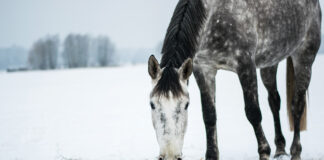A: This question gives me a great opportunity to share some ground-breaking research on the topic of horses drinking. I use the term “ground-breaking” even though the research is over 20 years old, because it completely changed what we thought we knew about drinking water preferences in horses.

Using a herd of feral ponies at New Bolton Center, the large animal campus of the School of Veterinary Medicine at the University of Pennsylvania, behaviorist Dr. Sue McDonnell and a team of researchers studied the effects of water temperature on drinking behavior. They wanted to find out if indeed horses drank less water when the weather (and the water) turned cold. What they found was just the opposite of what most horse people have always thought.
In their experiment, they cycled the ponies through three scenarios:
- Offering the single option of warm water only
- Offering the single option of icy cold water only
- Offering both warm and icy cold water simultaneously
During cold weather, horses drank more volume per day of warm water (scenario No. 1) than icy cold water (scenario No. 2). But, when warm water and icy cold water were both available at the same time, horses drank almost exclusively from the cold water, and less of it. That is, horses prefer icy cold water, but they don’t drink as much cold water when compared to warm water. Dr. McDonnell and her team, as well as other equine behaviorists, aren’t sure why this is so, but horse owners can still use this information to encourage their horses to stay hydrated during the winter.
Hydration Helpers
If possible, only provide your horse with warm water during the chillier months. Ideally this would be at all times using a heater, but if continuously heated water is not an option, then use another helpful fact from this same study: horses do most of their drinking within three hours after feeding. Continuously heated water in this study ranged from 41 to 140 degrees Fahrenheit with an average of 66 degrees while buckets were refilled twice daily with hot water that ranged from 114 to 120 degrees and was in the range of 68 to 95 degrees when most drinks occurred.
In addition to providing warm water, two other ways to try and get more fluid into horses in the winter are to give electrolytes containing salt (sodium chloride) to stimulate thirst, and to add water to feeds such as hay, hay pellets and cubes, complete feeds, and beet pulp. The easiest way to meet the horse’s daily requirement of 1 ounce (about 2 tablespoons) of salt per day is to add it to the grain or the meals listed, but if you do choose to add it to the water, make sure there’s a second bucket of fresh water (with no salt added) available. And watered-down feed can take some getting used to for many horses so start by just moistening the food and gradually add more and more water until your horse tells you “that’s enough.”






